Wireless Operation
by Grim. Reaper

1. Carrier Sense Multiple Access / Collision Avoidance
1.1. Is a network multiple access method in which carrier sensing is used but nodes attempt to avoid collisions by beginning transmission only after the channel is sensed to be "idle"
1.2. Carrier Sense: ~ Prior to transmitting, a node first listens to the shared medium (such as listening for wireless signals in a wireless network) to determine whether another node is transmitting or not. ~ Note that the hidden node problem means another node may be transmitting which goes undetected at this stage.
1.3. Collision Avoidance: ~ If another node was heard, we wait for a period of time (usually random) for the node to stop transmitting before listening again for a free communications channel
2. Discovering Ap
2.1. Wireless devices must discover and connect to an AP or wireless router. Wireless clients connect to the AP using a scanning (probing) process
2.2. Passive mode - The AP openly advertises its service by periodically sending broadcast beacon frames containing the SSID, supported standards, and security settings. The primary purpose of the beacon is to allow wireless clients to learn which networks and APs are available in a given area, thereby allowing them to choose which network and AP to use
2.3. Active mode - Wireless clients must know the name of the SSID. The wireless client initiates the process by broadcasting a probe request frame on multiple channels. The probe request includes the SSID name and standards supported. Active mode may be required if an AP or wireless router is configured to not broadcast beacon frames
3. Authetication
3.1. ~The shared authentication method is commonly used on individual and small business wireless LAN implementations ~This method uses a shared key that is given to both sides of the connection; if they match then the device is allowed onto the network


